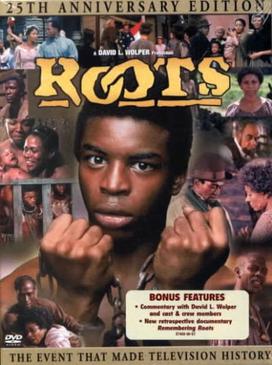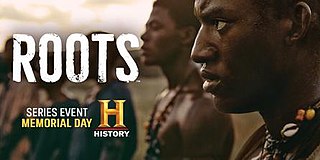
Alexander Murray Palmer Haley was an American writer and the author of the 1976 book Roots: The Saga of an American Family. ABC adapted the book as a television miniseries of the same name and aired it in 1977 to a record-breaking audience of 130 million viewers. In the United States, the book and miniseries raised the public awareness of black American history and inspired a broad interest in genealogy and family history.

Kunta Kinteh Island, formerly called James Island and St Andrew's Island, is an island in the Gambia River, 30 km (19 mi) from the river mouth and near Juffureh in the Republic of the Gambia. Fort James is located on the island. It is less than 3.2 km from Albreda on the river's northern bank. As an important historical site in the West African slave trade, it is listed as a UNESCO World Heritage Site, together with related sites including a ruined Portuguese chapel and a colonial warehouse in Albreda, the Maurel Frères Building in Juffureh, and Fort Bullen and Six-Gun Battery, which are located at the mouth of the Gambia River.

Roots is an American television miniseries based on Alex Haley's 1976 novel Roots: The Saga of an American Family, set during and after the era of slavery in the United States. The series first aired on ABC in January 1977 over eight consecutive nights.

Kunta Kinte is a fictional character in the 1976 novel Roots: The Saga of an American Family by American author Alex Haley. Kunta Kinte was based on one of Haley's ancestors, a Gambian man who was born around 1750, enslaved, and taken to America where he died around 1822. Haley said that his account of Kunta's life in Roots is a mixture of fact and fiction.

Roots: The Saga of an American Family is a 1976 novel written by Alex Haley. It tells the story of Kunta Kinte, an 18th-century African, captured as an adolescent, sold into slavery in Africa, and transported to North America; it follows his life and the lives of his descendants in the United States down to Haley. The release of the novel, combined with its hugely popular television adaptation, Roots (1977), led to a cultural sensation in the United States. The novel spent forty-six weeks on The New York Times Best Seller List, including twenty-two weeks at number one. The last seven chapters of the novel were later adapted in the form of a second miniseries, Roots: The Next Generations (1979). It stimulated interest in African American genealogy and an appreciation for African American history.
Hope was an American brig or sloop that made two voyages in the slave trade.
Lifeline Expedition is a non-profit organization founded in 1997 by Briton David Pott. The group believes white people must apologize for the Atlantic slave trade, and that forgiveness can be granted by black people from areas that were involved in it.

Roots is a 2016 American miniseries and a remake of the 1977 miniseries with the same name, based on Alex Haley's 1976 novel, Roots: The Saga of an American Family, which follows an African man who is shipped to North America as a slave and his descendants. It first aired on May 30, 2016 and stars Malachi Kirby, Forest Whitaker, Anna Paquin, Laurence Fishburne, Jonathan Rhys Meyers, Anika Noni Rose, T.I. and South African actress Nokuthula Ledwaba. It was produced on a budget of $50 million.
Kitty's Amelia was Jeune Amélie launched in France in 1802. A British letter of marque captured her in 1803 and she became a Liverpool-based slave ship in the triangular trade in enslaved people. Between 1804 and 1807 she made four voyages transporting enslaved people, but her chief claim to fame is that she performed the last legal slaving voyage for a British vessel. She was reported wrecked in 1809.
Eliza was launched in America in 1780 and taken in prize in 1782. She entered the Liverpool registry in 1783, 1786, and again in 1792. She made nine voyages as a Liverpool-based slave ship in the triangular trade in enslaved people. She was lost in an explosion on her tenth voyage after she had already embarked her captives. All the captives died, as did her captain and most of her crew. The explosion occurred during a single ship action on 17 December 1797, with a French privateer.
Lord Nelson was launched in 1798 at Liverpool and subsequently made five voyages carrying slaves from West Africa to the West Indies in the triangular trade in enslaved people. On her first voyage she helped suppress a revolt on another slave ship by that vessel's captives. This gave rise to an interesting case in salvage money. A French naval squadron captured her off Sierra Leone on her sixth voyage, before she had embarked any captives.
Hannah was built in Liverpool in 1795. She made four voyages as a slave ship in the triangular trade of enslaved people. She was lost in 1801 as she was returning home after having delivered her captives on her fourth voyage.
Horatio was launched in 1800 at Liverpool. She made four voyages as a slave ship in the triangular trade in enslaved people. During two of these voyages she was captured and recaptured. Shortly before the British slave trade ended she left the slave trade and sailed between Britain and South America and as a West Indiaman. She was wrecked in 1817.
Old Dick was launched at Bermuda in 1789. She sailed to England and was lengthened in 1792. From 1792 on she made two full voyages as a Liverpool-based slave ship in the triangular trade in enslaved people. On her second she recaptured two British merchant ships. She was lost in 1796 at Jamaica after having landed her third cargo of captives.
Harriot was launched in Liverpool in 1786. For many years she was a West Indiaman, sailing between Liverpool and Barbados. In 1796 a French frigate captured her, but the British Royal Navy quickly recaptured her. She became a slave ship in the triangular trade in enslaved people. At the beginning of her of her first slave trading voyage a French privateer captured her, and again the Royal Navy quickly recaptured her. She made five slave trading voyages in all. Thereafter she traded with South America. She was last listed in 1814 with stale data.
Mentor was the former HMS Wasp. The British Royal Navy sold Wasp in 1781 and she became the mercantile Polly, which traded with Africa. In 1784 Polly became the slave ship Mentor. Mentor made eight full slave-trading voyages in the triangular trade in enslaved people. She carried captives from The Gambia to the West Indies. French privateers captured her in late 1795 as she was on her way from West Africa to the West Indies on her ninth voyage.
Gambian Americans are an ethnic group of Americans of Gambian descent. There are about 8000 Gambians living in the United States, involving themselves in activities ranging from business and entrepreneurship to college education. Additionally, during the Atlantic slave trade, many Africans from what is now The Gambia were traded and were subsequently sold by Europeans and Americans into forced labor in the United States. Gambian immigrants arriving in the United States include members of ethnic groups such as the Mandinka, Wolof, Fula, Jola, and Serahule.
Black Joke was a ship built in 1720 or 1743. She appeared in Lloyd's Register (LR) in the issue for 1764.
True Briton was launched at Liverpool in 1775. She made two voyages as a slave ship in the triangular trade in enslaved people. During the second of these voyages there was an unsuccessful insurrection by the captives she was carrying. Then in 1777–1778 she made another enslaving voyage, this time under the name John. On her return to Liverpool, she became the privateer Bellona, and succeeded in taking several prizes. Bellona then made three enslaving voyages. In 1786 her ownership changed, and so did her name. She became Lord Stanley, and under that name proceeded to make 11 more enslaving voyages. In 1794, at Havana, a deadly fever spread through the vessel, apparently after she had landed her captives. On her last voyage the captain acted with such brutality towards a black crew member that the man, who providentially survived, sued the captain when the vessel arrived at Liverpool and won substantial damages.





